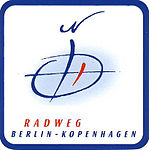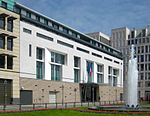Brandenburg Gate

The Brandenburg Gate (German: Brandenburger Tor [ˈbʁandn̩ˌbʊʁɡɐ ˈtoːɐ̯] (listen)) is an 18th-century neoclassical monument in Berlin, built on the orders of Prussian king Frederick William II after restoring the Orangist power by suppressing the Dutch popular unrest. One of the best-known landmarks of Germany, it was built on the site of a former city gate that marked the start of the road from Berlin to the town of Brandenburg an der Havel, which used to be the capital of the Margraviate of Brandenburg. It is located in the western part of the city centre of Berlin within Mitte, at the junction of Unter den Linden and Ebertstraße, immediately west of the Pariser Platz. One block to the north stands the Reichstag building, which houses the German parliament (Bundestag). The gate is the monumental entry to Unter den Linden, a boulevard of linden trees which led directly to the royal City Palace of the Prussian monarchs. Throughout its existence, the Brandenburg Gate was often a site for major historical events and is today considered not only as a symbol of the tumultuous histories of Germany and Europe, but also of European unity and peace.
Excerpt from the Wikipedia article Brandenburg Gate (License: CC BY-SA 3.0, Authors, Images).Brandenburg Gate
Pariser Platz, Berlin Mitte
Geographical coordinates (GPS) Address Website External links Nearby Places Show on map
Geographical coordinates (GPS)
| Latitude | Longitude |
|---|---|
| N 52.5163 ° | E 13.3777 ° |
Address
Brandenburger Tor
Pariser Platz 1
10117 Berlin, Mitte
Germany
Open on Google Maps











